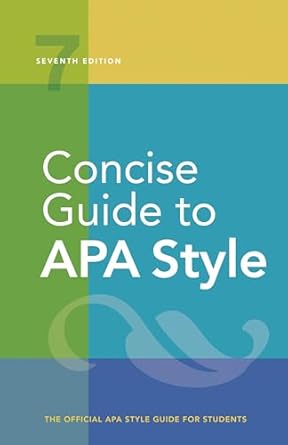[toc]
apa referencing mastering author date title source
Concise Guide to APA Style: 7th Edition (OFFICIAL)
Page 237 Review
Understanding APA Style References: A Detailed Commentary
This ebook excerpt provides a concise overview of the principles behind creating reference list entries in APA style.
It emphasizes the importance of understanding the fundamental elements and how they apply to both online and print sources.
The Core Principle: Consistency and Clarity
The passage begins by establishing a key principle: “APA Style references for online and print works are largely the same.” This underscores the effort to maintain consistency in referencing, regardless of the medium.
The focus is on providing clear and accurate information so that readers can easily locate the source material.
The Four Pillars of a Reference
The excerpt identifies the four crucial elements of a reference entry: author, date, title, and source.
Each element serves a specific purpose:
* Author: “Who is responsible for this work?”
* Date: “When was this work published?”
* Title: “What is this work called?”
* Source: “Where can I retrieve this work?”
These questions provide a helpful framework for constructing a reference, even when specific examples are lacking.
The passage rightly points out: “Considering these four elements and answering these four questions will help you create a reference for any type of work, even if you do not see a specific example that matches it.”
Online vs.
Print: Bridging the Gap
The distinction between online and print sources lies primarily within the “source” element.
As the text notes: “All references generally include the author, date, title, and source; differences between online and print versions are evident within the source element.
The source element includes information about where the work came from (e.g., a periodical’s title, a book’s or report’s publisher, a website’s name).” The inclusion of a DOI (Digital Object Identifier) for online works is highlighted as important when available. “References for works with DOIs also include the DOI in the source element, and references for most online works without DOIs include the work’s URL.”
However, the excerpt makes a crucial clarification about database information: “database information and/or database URLs are not usually included in references (see Section 9.30 for an explanation and a few exceptions).” This is a key point often overlooked, leading to unnecessarily lengthy and cluttered references.
Adapting to Missing Information
The passage acknowledges that reference elements can sometimes be “unknown or missing,” requiring adaptation. “Sometimes reference elements are unknown or missing and the reference list entry must be adapted.
See Table 9.1 for a summary of how reference elements are assembled and adjusted when information is missing.”
Practical Application
Figure 9.1 is mentioned as an example. “Figure 9.1 shows an example of an article title page highlighting the locations of the reference elements and showing their placement in a reference list entry.”
Why This Matters
The meticulous approach to referencing outlined in the APA style is essential for academic integrity and effective communication.
By consistently applying these principles, researchers and writers ensure that their sources are properly acknowledged and that their work can be easily verified and built upon.
The excerpt’s emphasis on understanding the underlying elements rather than simply following templates is particularly valuable, empowering individuals to create accurate references even in less common situations.
Conclusion
This excerpt provides a solid foundation for understanding APA style referencing.
By focusing on the four key elements and adapting them appropriately, writers can create clear, accurate, and consistent reference list entries for both online and print sources.
The excerpt’s emphasis on understanding the ‘why’ behind each element is particularly helpful in navigating the complexities of academic writing.
Buy full ebook for only $18: https://www.lulu.com/shop/american-psychological-association/concise-guide-to-apa-style-7th-edition-official/ebook/product-rmzpq54.html?page=1&pageSize=4


Leave a Reply